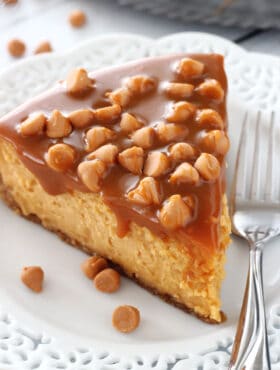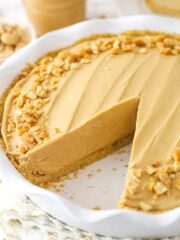This post may contain affiliate sales links. Please read my disclosure policy.
This Loaded Butterscotch Cheesecake might literally be the best cheesecake I’ve ever had, let alone made. It is so darn good. Every bite explodes with creamy, rich butterscotch flavor.

Loaded Butterscotch Cheesecake
So I have a tendency to fall in love with new songs and then play them over and over. It’s totally a thing I do. I’ll bake, work, whatever with the song, or few songs, basically on repeat in the background.
Lately I’ve had 3 or 4 that I’m totally into. I’ve been listening to them while I bake at night.
Then the hubs and I were in the car the other day and one of them (Ellie Goulding – Love Me Like You Do) came on the radio. I was like, “Ohhh, it’s my song.” And he was like, “Oh, I know.”
For some reason, I’d kind of assumed he totally ignored me, what I was listening to and my singing. He’s usually in his office with the door closed.
Then he was all, “And you always sing the same part.” And I had no idea what he was talking about. The same part? All I could remember was singing the song in general. No specific part. But whatever.
Then a part of the song came on and I immediately started to sing it out loud and he was like, “There it is!”
I couldn’t help but laugh. It’s amazing to me sometimes that he notices that stuff. I had no idea I tended to do that. Now every time I hear the song, I think about it – and I always want to belt out the same part. Thank goodness he loves me. 🙂
Truth is I love to sing (although I can’t actually sing) and dance around. And sometimes, when I’m lucky, the hubs will get goofy with me and sing things like Disney songs with me. Don’t tell him I told you though! He’ll never do it again! And that would make me sad.
On another note, it would also make me sad if I’d never gotten to eat this cheesecake. You might not believe me, but you need this cheesecake. Ridiculous. So good.
I packed it with butterscotch flavor – because that’s what I do. Strong flavors.
Tips for Making Loaded Butterscotch Cheesecake
At first, I just used a butterscotch pudding mix to flavor the cheesecake. It was fine, but not enough. I wanted straight butterscotch.
So I added butterscotch chips. And then more butterscotch chips in the form of ganache. Then more on top. The final result is perfect. You will want to keep the whole cheesecake to yourself. It’s addicting.
The butterscotch chips get melted on the stove, then the pudding is added (with less milk than normal). It will definitely thicken when combined, so you want to make sure you add it to the cream cheese mixture while warm so that it incorporates well.
This baby was a hit! So loved by all. You might be tempted to be all, “I just want one bite,” but you will break after that one bite. You will. It’s that good.
You might also like:
Ultimate Butterscotch Cake
Pumpkin Butterscotch Chip Cookies
White Chocolate Butterscotch Tart
Double Pumpkin Butterscotch Rice Krispy Treats
Butterscotch Toffee Cookies

Loaded Butterscotch Cheesecake
- Prep Time: 45 minutes
- Cook Time: 2 hours 25 minutes
- Total Time: 3 hours 10 minutes
- Yield: 12-14 Slices
- Category: Dessert
- Method: Oven
- Cuisine: American
Description
This Loaded Butterscotch Cheesecake might literally be the best cheesecake I’ve ever had, let alone made. It is so darn good. Every bite explodes with creamy, rich butterscotch flavor.
Ingredients
CRUST
- 1 1/4 cups nilla wafer crumbs
- 4 tbsp butter
- 4 tbsp brown sugar
FILLING
- 24 oz cream cheese, room temperature (three 8 oz packages)
- 1 cup sugar
- 3 tbsp flour
- 4 eggs, room temperature
- 1 tsp vanilla extract
- 1 cup milk, divided
- 1 cup butterscotch chips
- 3.4 oz package dry Butterscotch pudding mix
TOPPING
- 1 1/2 cups butterscotch chips
- 4 1/2 tbsp heavy cream
Instructions
Nutrition
- Serving Size: 1 Slice
- Calories: 288
- Sugar: 28.5 g
- Sodium: 372.5 mg
- Fat: 13.8 g
- Carbohydrates: 34.9 g
- Protein: 6.9 g
- Cholesterol: 87.8 mg
Filed Under:
Enjoy!






























